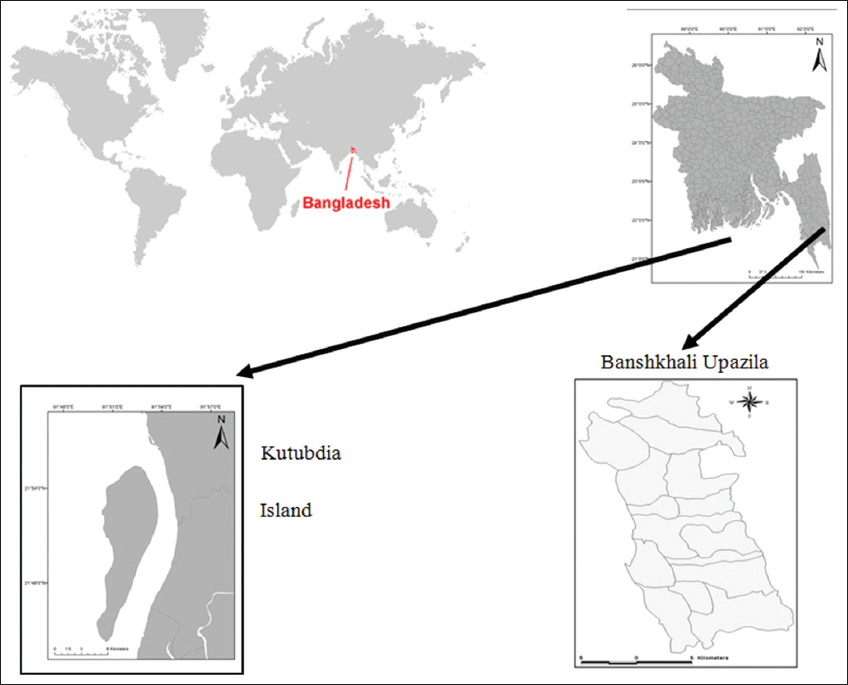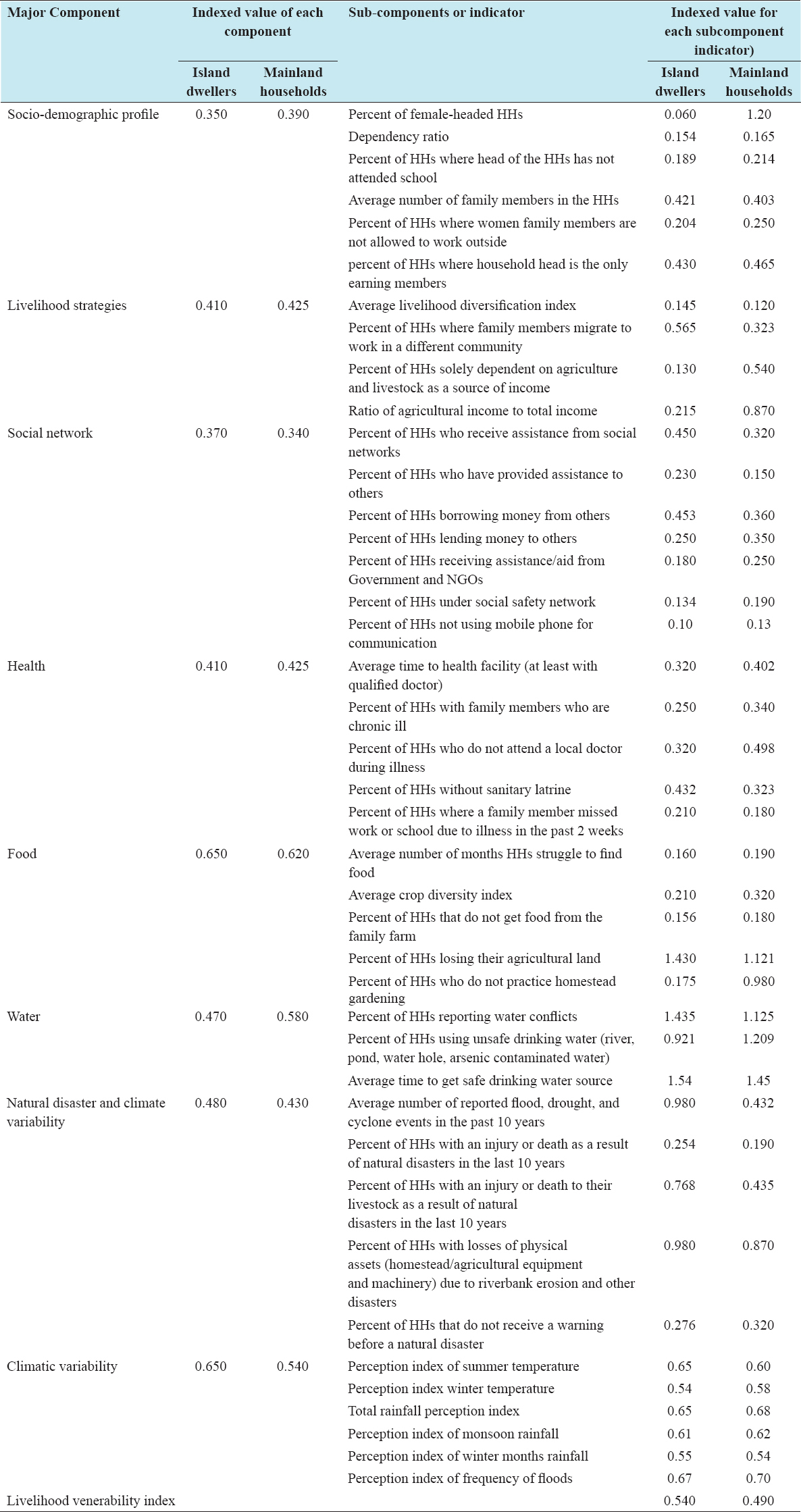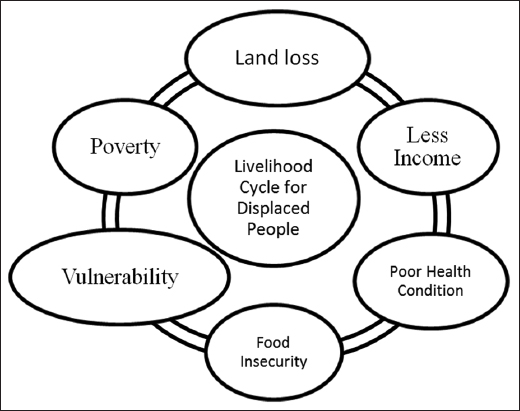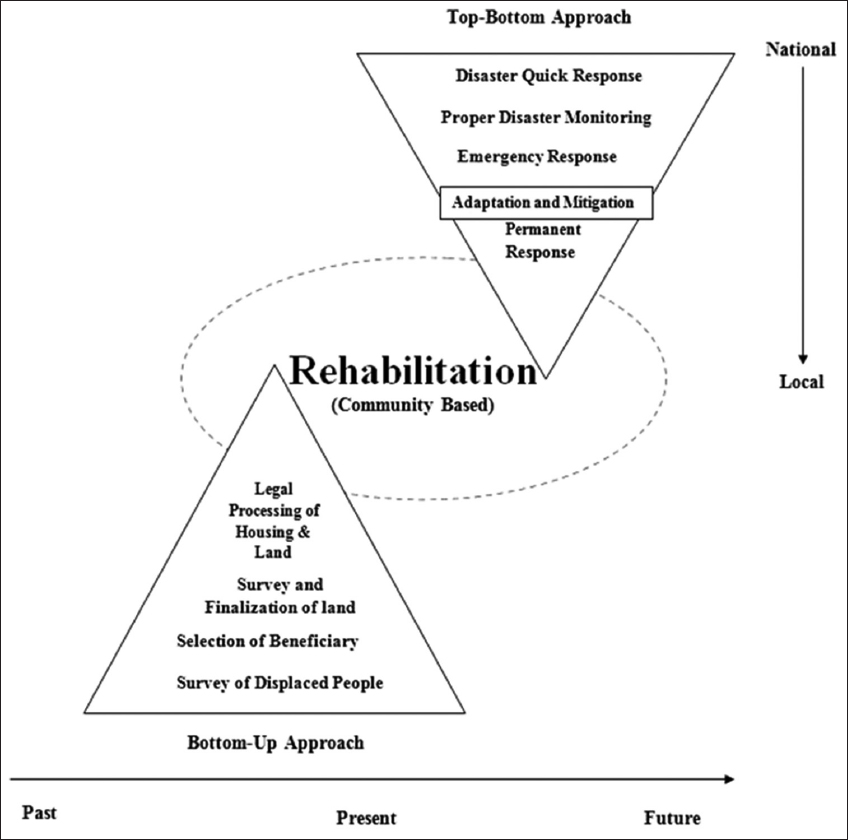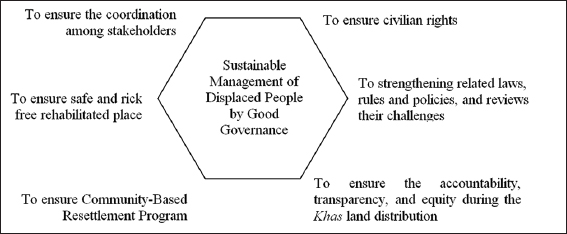INTRODUCTION
Climate change is expected to creating global, regional, and local changes in many fundamental approaches of the climate system. Some of the projected climate changes and their associated vulnerabilities imply important consequences for the coastal communities.[1] The coastal area of Bangladesh consists of 19 districts, which cover 32% of the country and accommodate more than 35 million people. Climate change-induced extreme weather events, primarily hydrometeorological in nature, will significantly affect displacement in three distinct ways in Bangladesh. First, the effects of warming and drying in some regions will reduce agricultural potential and undermine “ecosystem services” such as the availability of clean water and fertile soil. Second, heavy precipitation will cause flash or river floods in tropical regions. Moreover, finally, sea level rise will permanently destroy extensive and highly productive low-lying coastal areas that are home to millions of people who will have to relocate permanently.[2]
Displacement as a result of climate change is not a new phenomenon. The link between climate change caused by human interferences with the world and environmental vulnerability has now been well established. Climate change is expected to affect the people displacement from their living home and land in at least four ways: (1) The escalation of natural disasters both rapid and slow-onset leading to increased displacement as well as migration; (2) the adverse consequences of increased warming, climate variability, and other impact of climate change on livelihoods, health, food security, and water availability; (3) rising sea levels which create coastal areas ; and (4) competition over limited natural resources potentially leading to increasing tensions and even conflict and, in turn, displacement.[3,4]
Bangladesh is widely recognized to be the worst victim of climate change and affected by salinity intrusion, destabilization of rivers, increase in extreme weather events, submergence of a large part of the country, and spread of diseases and epidemics.[5,6] It has been ranked as one of the world’s most disaster-prone countries, with 97.1% of its land area and 97.7% of its population at risk from multiple hazards.[7] However, climate-induced changes such as extreme cyclone, devastating tidal surges, severe floods, treacherous river erosion, excessive rainfall, thunderstorm, and overwhelming salinity intrusions occur more frequently and unpredictably in the coastal region of Bangladesh.[8,9] Besides, climate-induced disasters such as cyclone, tidal surge, flash flood, coastal erosion and trans-regression, heavy rainfall, salinity, and thunderstorms are frequent, recurrent, and much familiar disasters to coastal people in the southern coastal belt of Bangladesh.[10] As a result, first, the effects of warming and drying in some regions will reduce agricultural potential and undermine “ecosystem services” such as the availability of clean water and fertile soil. Second, heavy precipitation will cause flash or river floods in tropical regions. Moreover, finally, sea level rise will permanently destroy extensive and highly productive low-lying coastal areas that are home to millions of people who will have to relocate permanently.[6] Of Bangladesh’s 64 districts, 26 coastal and mainland districts are already producing climate displaced people: It is estimated that 6 million people have already been displaced by the effects of climate hazards in Bangladesh. Nearly 46% of people temporarily displaced and 12% of people permanently displaced due to different hazards in four climate hotspots of Bangladesh.[11,12] In the present situation, the coastal zone of Bangladesh hosts over 35 million people who are exposed to cyclones, storm surges, rough seas, salinity intrusion, and permanent inundation due to sea level rising. It was also found that almost 60 lakh people were displaced from their home and land due to climate change in Bangladesh.[13,14] Although no specific study has been found to relate between climatic-induced disasters and displacement pattern in the coastal area of Bangladesh, the present study has been investigating the climatic-induced disasters and displacement pattern in the coastal area of Bangladesh. On the other hand, it is revealed that, due to the impact of climate change, sizes of Kutubdia Island reduced almost 50% in the past 20 years. Since 1991, six villages on the island have completely gone under the sea and about 40,000 people have fled, and most of them got temporary shelter to the coast near Cox’s Bazar.[15] In Bangladesh, the present condition of good governance is not satisfactory. There are many problems that are stimulated as barriers for good governance. In this case, the present study tried to investigate the conditions and changes of socioeconomic conditions between the pre/origin and the post/destination of displaced people in the coastal areas of Bangladesh.
The study mainly focuses on the answering about the conditions and changes of socioeconomic conditions and basic needs between the origin and destination of displaced people in the coastal areas of Bangladesh. Besides, it is also for establishing the association between the conditions and changes of socioeconomic conditions between the pre/origin and the post/destination of displaced people. For statistical interpretation, the null hypotheses (Ho) were adopted. To analyze the data more strictly, an attempt was made to statistically interpret the relationship between “socioeconomic conditions between the origin and destination areas of displacement people.”
Ho: There is no change of socioeconomic conditions between the origin and destination areas of displaced people.
MATERIALS AND METHODS
Selection of the Study Areas
The Southeastern coastal area enriched with numbers of important and vulnerable islands which have a historical record of displacement and migration over the long time. The authors considered the record of Climate susceptibility, displacement rates, land erosion, recurrent disaster for selection of the study areas. The authors selected Kutubdia Island (Subdistrict) and Banshkhali subdistrict as mainland for the study. Kutubdia Island belongs to the Cox’s Bazar District, and Banshkhali belongs to the Chittagong District [Figure 1]. People are living in the areas which are the most cyclonic disaster and erosion-affected area in Bangladesh.
Figure 1: Geographical location of the study areas
Data Collection
Both qualitative and quantitative approaches have been applied. Qualitative data have been collected through participant observation, key informant interviews (KIIs), and focus group discussion (FGD) checklists, besides quantitative data were gathered through questionnaire survey method, respectively. A total of 10 KIIs were interviewed, among which 8 KIIs were conducted in displaced areas and 2 KIIs were done in destination areas. KII have been conducted with 2 Cox’s Bazar and Chittagong Additional Deputy Commissioner ( Revenue), 2 Union Parishad Chairman, 2 with Journalists, 2 with Upazila Chairman and 2 Upazila Nirbahi Officer of Banshkhali and Kutubdia upazila respectively. A total of 6 FGDs were completed, among which 4 FGDs were conducted in displaced areas and 2 were conducted in destination areas separately.
A semi-structured questionnaire has been applied for quantitative data collection at the household level of displaced people from displaced and destination places. Sampling frame has been developed after collection of total population in both the study areas. The sample size has been chosen in line with a statistical formula.[16]
Where, n0 denoted the desired sample size; z = standard normal deviate usually set at 1.96, which corresponds to the 95% confidence level (1.96); p = assumes proportion in the target population estimated to have a particular characteristic (0.50); q = proportion of the estimation of population (1-p = 0.50); and d = allowable maximum error in estimating a population proportion (0.05), respectively.
Besides, the simple random sampling technique has been adapted for successfully operating of 410 questionnaires at a household’s level of the displaced people [Table 1].
Table 1: Distributed of population on the two selected study areas
The representative sample size has been distributed on the statistical way with the help of following formula:
Where, Nj = the sample size; N = total population size, (N = ni + nii + niii +……+ nn); Ni = population size of the study area, and n= desired sample size separately.
Meaningful data have been edited, coded, classified, and tabulated the sequential manner. Qualitative data have been examined with the help of two theories such as “grounded theory” and “narrative analysis,” besides quantitative data were interpreted with the help of two analyses such as “statistical analysis”’ and “analytical analysis,” respectively. Moreover, statistical and analytical analysis of the study was done with the help of statistical techniques, especially Statistical Package for the Social Science: version-16 and various statistical tools such as tables, charts, graphs, diagrams, figures, and photographs.
Vulnerability Analysis for Displaced People
The IPCC suggests that vulnerability is characterized as a function of three dimensions - exposures, sensitivity, and adaptive capacity, as follows:[17]
Vulnerability = f (Exposure; sensitivity; adaptive capacity).
Vulnerability is a positive function of the system’s exposure and sensitivity and a negative function of the adaptive capacity. The authors applied livelihood vulnerability index (LVI)[18] and the climate vulnerability index (CVI) to measure and compare livelihood vulnerability in the context of the coastal area inhabitants’ living condition.[19] The LVI approach is preferred over the sustainable livelihood approach, which only considered five types of household assets - natural, social, financial, physical, and human capital - but failed to integrate the issues of sensitivity and adaptive capacity to climate change.[20] The present study develops a weighted balance integrated approach to the calculation of the LVI and CVI that incorporates local and indigenous knowledge into the selection of indicators.
Chi-square (χ2) test
For statistical analysis of probability sampling or justification of hypothesis, the research has been carefully applied Chi-square test. Following equation has been used for the determination of the Chi-square test.
Where O denotes the total number of observation or sample size or observation value and E denotes the expected value.
For statistical interpretation, the null hypotheses (Ho) were adopted for determining the relationship between “resettlement program and people’s displacement” in the coastal area of Bangladesh. For justification of the hypothesis, the study has been applied nine types of indicators such as monthly income, types of occupation, pattern of housing, source of drinking water, sanitation condition, health-care facilities, children’s education, the nature of security, and social and cultural harmony. The indicators have been selected on the basis of the Bangladesh Bureau of Statistics, Finance Division, Bangladesh Bank, Ministry of Health and Family Welfare, 2017. Along with, for data authenticity and accuracy, age structure has been discussed.
Changing Pattern of Livelihood for Climate Displaced people
After the result datasheet has been found, according to the desired questionnaire, then the authors applied Likert scale method[21] that is common rating format for surveys. Comparative study of displaced peoples’ livelihood scenario and living status between before and after displacement has been figured out by Likert scale method, and the format of a typical five-level Likert item is as follows:
1 - Strongly disagree, 2 - Disagree, 3 - Neutral, 4 - Agree, and 5 - Strongly agree.
Based on the result of respondent statement, the authors rank the weight ranking in three categories such as:
Strongly Dissatisfied - Below 3, Neutral - 3.00, and Strongly Satisfied - Above 3
RESULTS AND DISCUSSION
Demographic profile of the respondents is a precondition for people’s perception-based research because it especially explores the current situation of the selected issue in the study areas, authenticity of the data collected, and severity and magnitude of the problem considered. Table 2 provides the demographic profile of the respondents.
Table 2: Respondents demographic and socio-economic condition
Livelihood Assets and Activities
A livelihood comprises the capabilities, assets (stores, resources, claims, and access), and activities required for a means of living: A livelihood is sustainable which can cope with and recover from stress and shocks, maintain or enhance its capabilities and assets, and provide sustainable livelihood opportunities for the next generation (Chambers and Conway, 1991). By utilizing five types of assets, coastal community survives. The authors found the different types of assets with percentage and livelihood activities in the study areas which are shown in Table 3. In the study areas, people were found engaged in most common income-generating activities including agriculture, cattle rearing, fishing, rickshaw pulling, and day laboring and some were involved with business.
Table 3: Livelihood assets and activities in the study areas
Origin and Destination for Displaced People
In Bangladesh, the vast majority of these people has been displaced domestically - not across international borders - presenting the government with enormous challenges, particularly when it comes to finding places to live and work for those who have been displaced. There are very few resettlement program for landless/homeless people in Bangladesh where 10% people rehabilitated and for that reason mass people has been forced to displaced in the south-eastern coast of Bangladesh. Climate Displaced people mostly receiving short term relief from the Government and other organization.[22,23] Unfortunately, after displacement, people go to the outer side of their Upazila in Kutubdia area, besides people stay in their own Upazila in Banshkhali area, respectively [Table 4].
Table 4: The origin and destination for displaced people in the study area
LVI for Displaced People
From the present study, it is found that households in Kutubdia and Banshkhali were found to be vulnerable to climate change issues. However, the overall LVI of 0.540 was a little higher for the coastal island compared to that of the mainland households (0.490) [Table 5]. This indicates that livelihood of island dwellers is more vulnerable than mainland households. This is happened because Kutubdia Island has a long history of coastal erosion and displacement problem. The study found a little difference in the estimated index value for different sociodemographic profiles for the study sites. The index value of “livelihood strategies” and “social network” was not differing much across sites which were 0.410 and 0.370 for island dwellers and 0.425 and 0.340 for mainland households, respectively. On the other hand, the index value of “food,” “water,” and “health” was the highest for mainland dwellers rather than island dwellers. On the other hand, the index value for “natural disasters” and climate variability was found highest for island dwellers.
Table 5: Indexed value of major components and sub-components comprising the livelihood vulnerability index
The indexed value for social network differed slightly across sites. The indexed values for access to “food” and “water” were the highest for char dwellers with the value of 0.757 and 0.287, respectively, as against 0.628 and 0.188 for river-bank households; these findings are contextualized below. The indexed value for natural disasters was the highest for char dwellers due to their low-lying topography and vulnerability to floods, while climate variability was found to impact on both communities equally [Table 5].
CVI for Displaced People
The various dimensions of vulnerability are presented in Table 6. The CVI was 1.452 and 0.950 for island dwellers and mainland areas of Southeastern and Western coastal areas, respectively, which indicates that households in both the areas are vulnerable to climate change and variability [Table 6].
Table 6: Climate vulnerability index for island dwellers and mainland dwellers in study area
The study households are not only vulnerable to cyclone, tidal flood, and coastal erosion but also to other climatic hazards. The climate change vulnerability index value of the three dimensions - adaptive capacity, sensitivity, and exposure - contributed to the CVI of the coastal inhabitants’ households. It is noticeable from the results in Table that there is a variation in the level of adaptive capacity, sensitivity, and exposure across the study sites. The highest sensitivity and exposure value contributed to the highest CVI for island dwellers. However, higher value of CVI in both the sites indicates their higher vulnerability to climate change. The indicators of “food,” “water,” and “health” were comparatively higher for island dwellers than for mainland households. The coastal mainland area households are relatively less vulnerable due to many reasons, such as higher opportunities to diversify their income sources, low dependency ratio, higher level of education, better economic condition, and being better connected to transport and other services. On the other hand, island dwellers frequently suffered natural disaster and they have experienced for coping with disaster vulnerabilities and habituated than mainland dwellers. The above discussions indicate that access to “food,” “water,” and “health” facilities is the main drivers of the livelihood vulnerability of the study households.
Disasters vary considerably in their potential to instigate displacement.[24,25] Field survey illustrated that, due to frequent natural disasters, almost all island dwellers have experiences of three types of displacement in their life which are (1) temporary displacement, (2) permanent local displacement, and (3) permanent internal displacement.
Livelihood Cycle of Climate Displaced People
A vicious circle of land access, food security and poverty, loss of land due to cyclone, tidal surges, and coastal erosion becomes the age-old problem in Bangladesh, causing the loss of farmland and development opportunities. Health and well-being are a significant enabler for efficient farm and non-farm activities and assess the individuals’ and households’ ability to achieve their livelihood objectives.[22] From the study, it is found that undernutrition due to insufficient food, inadequate intake of food calories, and lack of health facilities influence on an individual’s ability to perform income- and non-income-related activities ultimately increasing vulnerability and causing a burden on the household and society of Kutubdia and Banshkhali. This research found that the livelihood conditions of the households of the study areas tend to follow a vicious circle from low livelihood opportunities to increasing poverty [Figure 2].
Figure 2: Livelihood cycle for climate displaced people
This is happened due to their existing poor livelihood conditions and their opportunities to earn income become limited. This limited income also has influence in the impacts on household food intake since the main source of household food supply is either from domestic production or market purchases. Land loss due to coastal erosion reduces the food production and income generation, and low income reduces household purchasing power. Lack of inadequate food intake influence negatively on manual labor coupled with limited facilities to access to health services and low affordability of medicines makes household members prone to disease in the study areas. Poor health and lack of access to health facilities limit off-farm activities and further reduce income-generating potential, forming a vicious circle of poverty, and malnutrition for climate displaced people.
Relation of Socioeconomic Conditions of Displaced People
When people are temporarily displaced during any disaster, they are able to return their home for a certain period if their homesteads remain safe. However, if they lost their homestead, they have to find the alternative shelter to survive. People’s displacement in Kutubdia and Banshkhali is a common phenomenon as a result of climate change-induced disasters. People of these two Upazilas are moving here and there after displacement to find the shelter and livelihood to survive. Often they are to start everything newly in new place such as shelter, environment, livelihood, and lifestyle, which put them very challenging situation. Table 7 explores the relation between socioeconomic condition of displaced people in the pre- and post-displacement situation of both the study areas. To analyze the data more strictly, an attempt has been made to statistically interpret the relationship between socioeconomic condition of displaced people in the pre- and post-displacement situation. For this aspect, a null hypothesis is as follows, Ho: There are no changes of socioeconomic condition of displaced people comparing with before and after displacement situation.
Table 7: Socioeconomic condition of displaced people comparing with before and after displacement situation
Chi-square test has been performed after cross-tabulation. Table 3 shows the results with the levels of significance for the Chi-square test. Rejecting the null hypothesis, there is no association or significant difference in frequency occurring socioeconomic condition between the pre- and post-displacement. The Chi-square test results indicate that a significant difference exists in socioeconomic condition between the pre- and post-displacement in both the study areas. Table 7 illustrates that monthly income, types of occupation, pattern of housing, sanitation condition, children educational status (study area-II), and the nature of security were significant (Hypothesis (Ho) = Calvalue Tabvalue = Significant) in the pre- and post-displacement in both the study areas. As a result, the null hypothesis (Ho) was rejected and the alternative hypothesis (H1) was accepted. Besides, source of drinking water and health-care facilities was non-significant (Hypothesis (Ho) = Calvalue Tabvalue = Non-significant) in the pre- and post-displacement in both the study areas. As a result, the null hypothesis (Ho) was accepted and the alternative hypothesis (H1) was rejected.
From the study, it is found that changing pattern of monthly income of climate displaced people in pre- and post-displacement situations was significant [Table 7]. Although their income level positively changed from pre- to post-displacement situation, satisfaction level was low compared to the pre-displacement situation in both the study areas. Displaced people claimed that, although their monthly income increased, it was insufficient in their families.
Types of occupations of climate displaced people in the pre- and post-displacement situation were significant [Table 7]. Although in the pre-displacement situation, villagers were engaged in one or more types of occupation at a time and nobody was unemployed. However, unemployment problem was a common scenario in the post-displacement situation. In original areas, people met traditional occupations which were practiced from their father and grandfather, besides brotherhood relation existed between occupation owners and workers. As a result, nobody was left unemployed. Furthermore, in destination areas, displaced people faced new or unknown environment where none of them were known. As a result, they could not get themselves engaged in new occupations easily. Finally, they faced hardcore poverty, eventually engaged in different informal activities.
Housing condition of climate displaced people in the pre- and post-displacement situation was significant [Table 7]. The housing pattern did not change in the pre- and post-displacement situation in the study area- I, though people move beyond their island or Upazila after a certain period to find the shelter and livelihood. Besides, in the Banskhali, the house pattern was built with local materials, particularly straw build house, earthen wall and tin, earthen roof and straw, “Gool Pata,” and so on. As a result, their housing pattern did not change in pre- and post-displacement areas.
Sources of drinking water of climate displaced people in the pre- and post-displacement situation were non-significant [Table 7]. Hence, the same proportions of drinking water sources and their satisfaction level were non-significant of null hypothesis. In Banskhali area, after displacement, most of the villagers did not go out of their locality. They rebuilt their house on polder/embankment in the same village; as a result, their drinking water sources were the same.
Sanitation condition in the pre- and post-displacement situations of the displaced people was significant [Table 7]. In the study area-I, displaced people used open place and open toilet and also few portions were used hygienic toilet for sanitation purposes in the pre-displacement situation. Besides, most of displaced people were used hygienic toilet and most of them used the open toilet in the post-displacement situation. In the study area-II, displaced people used the open place along with hygienic toilet and the situation did not change among pre- and post-displaced situations.
Health-care facilities of climate displaced people in the pre- and post-displacement situation were non-significant [Table 7]. In the study area-I, villagers received health-care services from Polli Doctor in the pre-displacement situation. Large proportions of displaced people received health-care services from local pharmacy, Polli Doctor, union health-care center, and government medical in the post-displacement situation. In Banskhali area (pre- and post-situation), displaced villagers received health care from the Polli Doctor in pre- and post-displacement situations. Health-care facilities were almost the same as well as their satisfaction level in both the study areas.
In Kutubdia area, children’s education of climate displaced people in the pre- and post-displacement situation was non-significant, beside it was significantly in a Banskhali area [Table 7]. In both the study areas, the children’s education of displaced people received from government educational institution in pre- and post-displacement situations. After displacement, guardian or displaced people were not interested to provide child education in both the areas. The security condition of climate displaced people in the pre- and post-displacement situation was significant [Table 7]. In Kutubdia areas, villager only felt risk of natural disaster in the pre-displacement situation. However, in the post-displacement situation, displaced people felt not only risk of natural disaster but also local political harassment and gangster/muscle man problem. In Banshkhali area, villagers only felt the risk of natural disaster in the pre-displacement situation. However, in the post-displacement situation, displaced people felt not only the risk of natural disaster but also local political harassment.
The social and cultural harmony in the pre- and post-displacement situation was significant [Table 7]. After displacement in both the study areas, displaced people were facing a lot of negative things such as specified by the society, social stratification, local political and musclemen violence, and economic crisis. This is happened because displaced people are new in the new area and for that local community not trust them, they are facing insecurity, lost social and cultural harmony. As the lifestyle of the displaced people is very different from the local settlers, they are not accepted so easily in the community. Displaced people are deprived of their rights, dominated by the local people, threatened and afraid, and victimized for their marriageable offspring. They often faced an identity crisis as well. Local people tend to show unwilling behavior when the displaced people sent their children for education and also they were deprived of basic and urban amenities.
Proper Rehabilitation Practices in Coastal Area of Bangladesh
This study strongly prescribed the “Community Based Rehabilitation Program” for displaced people in the coastal areas of Bangladesh. This study strongly recommended non-specialized rehabilitation program, especially “Community based Rehabilitation Program,” which is strongly recommended in this research; however, rehabilitation programs such as “Gucchogram,” “Ashroyon,” “Abason,” and “Adrasha Village” are discouraged. The existing rehabilitation program has been accelerated a lot of negative things such as displaced people specified the society, create social stratification, built mythological ideas, facing local political and mussel man violence, facing economic crisis because nobody trust him, feeling psychological stress, loss of social, cultural norms and value, and so on. Displaced people are deprived from their rights, dominated by the local people, threatened and afraid, and victimized for their marriageable off-springs. They often face identity crisis as well. Local people tend to show unwilling behavior when the displaced people send their children for education. They are deprived of basic and urban amenities.[2] This rehabilitation program is recommended for the displaced people to rehabilitate in a community so that they can be known and create their legal representative and welfare committee. This rehabilitated area should be safe and stay beside from other functional areas. Thus, following approaches are mentioned: The holistic approach has been divided into two categories such as “top-bottom” and –“bottom-up” approaches [Figure 3].
Figure 3: Holistic Approach for ensuring the “community based rehabilitation program”
There are four stages or steps of proper rehabilitation of displaced people in Bangladesh such as survey of displaced people, selection of target people, exploration for finalization of appropriate land and finally legal processing of land and housing. These process have been required for integrated rehabilitation process for climate displaced people in Bangladesh.
CONCLUSION AND RECOMMENDATIONS
Bangladesh is an overpopulated and a disaster-prone country in the South Asian region. Climate-induced disasters are recurrent and reduce the agricultural potentiality and undermine the “ecosystem services” such as the availability of clean water and fertile soil. Such disasters are also responsible to destroy the extensive and highly productive low-lying coastal areas that are home to millions of people who have to relocate permanently (Morton et al. 2008). It declines the poverty line and interrupted the achievement of the millennium development goals. In this situation, the study has been prescribed the following recommendations with considering the opinions of different stakeholders, especially experts, researchers, academicians, planners, local government representatives, related government high-level officials and their related agencies, journalists, local public representatives, and so on [Figure 4].
Figure 4: Sustainable management of displaced people in Bangladesh
These recommendations would ensure the good governance and proper coordination among government and NGOs or development partner during the resettlement program. Such as:
-
Government should ensure civilian rights of displaced people, mainly humanitarian assistance in emergency period, housing and shelter, land, food, water and sanitation, education for school children, health -care facilities, freedom of movement, choose their residential location, and relocate.
-
Strengthening the existing climate change or disaster-related laws, rules and policies, and reviews and updated these on the aspect of the contemporary situation. The government should develop and implement those by complying with the international rights-related convention and national rights-based laws and policies that ensure the effective protection of climate displaced communities in Bangladesh.
-
Government or related agencies should ensure the priority-based rehabilitation program of the displaced people to get khas land at pre- and post-displaced situation.
-
Non-specialized resettlement program or “community-based resettlement program” means boundary-less area, non-specificity, and does not remark the displaced people and their livelihood areas. It will be ensured their permanent settlement, dignity, local hood, sociocultural harmony, and local wisdom. As a result, they will create their legal representative and welfare committee. Finally, they will be united and strong and are able to protect themselves.
-
The rehabilitated place should free from disaster, easily communicate with other community, easily to meet their basic amenities, free from local political and mussel man violence, and meet in religious, social, and cultural harmony equally.
-
Government should ensure that all the persons selected are in free and fair and no political and illegal influences during rehabilitation program.
-
Government should ensure the coordination among stakeholders, particularly government-related agencies and NGOs/development partner. It will ensure the relocation/rehabilitation of displaced people in the most effective way.

